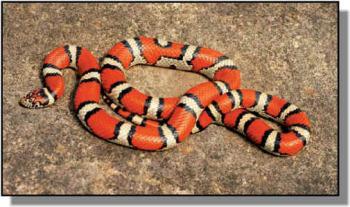 Popular Pet Snake: Milk SnakeAs pets go, snakes are growing in popularity. You can buy them at snake
shows, over the internet, at pet shops and, unfortunately, even through
some underground snake selling networks. The rationale some sellers
will give you -- they make the perfect pet because they are clean and
don't require much care -- may be designed to get a quick sell, but it
really isn't true. In fact, before you decide that a snake is the
right pet for you, think about what you are getting into by bringing a
creature into your home that will never become truly fond of you, will
let you you know that it doesn't want to be picked up by biting you, and
has a diet that pretty much consists of rats. Oh, and one more thing, a
high precentage of reptiles are carriers of Salmonellosis, a sometimes
deadly disease.
Popular Pet Snake: Milk SnakeAs pets go, snakes are growing in popularity. You can buy them at snake
shows, over the internet, at pet shops and, unfortunately, even through
some underground snake selling networks. The rationale some sellers
will give you -- they make the perfect pet because they are clean and
don't require much care -- may be designed to get a quick sell, but it
really isn't true. In fact, before you decide that a snake is the
right pet for you, think about what you are getting into by bringing a
creature into your home that will never become truly fond of you, will
let you you know that it doesn't want to be picked up by biting you, and
has a diet that pretty much consists of rats. Oh, and one more thing, a
high precentage of reptiles are carriers of Salmonellosis, a sometimes
deadly disease.
It’s impossible to estimate how many people keep snakes as pets. There are no requirements for licenses, as with dogs and cats, and many people who own snakes don’t have any reason to report them. But, if one of your children really has
decided that a snake is his or her pet of choice, or if you’re thinking of getting one yourself, here are a few things to consider before you bring home a snake.
You’ll need a tank,
terrarium, or aquarium big enough to
accommodate your new pet comfortably, meaning one that will allow the reptile
to stretch out to at least two-thirds of its length. Is this something you have room for or even want to have in one
of the rooms in your home?
One end of the tank should be heated, allowing the snake to regulate its body temperature by moving from one side of the enclosure to the other. Snakes are escape artists, able to squeeze through openings that you would never believe were large enough. So the lid and any other openings on the tank must always be secured.
Have room in your freezer for a rat or two? Snakes eat rodents so if it bothers you to handle mice or rats, even dead ones, forget about owning a snake. They don’t eat every day, but if you have to go away for an extended period, you will need to find a snake sitter to care for your pet. You’ll also need to find a vet who treats reptiles.
Some snakes can live for 30 years in captivity, often longer.This means you need to be prepared for a long-term commitment with your new friend.
Your snake will never grow fond of you, no matter how long you keep it. Snakes are incapable of having emotion of any kind, not love or affection or loyalty. Their brains simply have not evolved to the extent where that is even a possibility.
You can’t train snakes to do anything. A snake doesn’t have ears and is deaf, so it’s not going to come to you when you call it. All of its reactions are simply instinctive.
All snakes bite. If the snake can’t get away and feels threatened, cornered, or simply doesn’t want to be handled, it will strike and try to bite you. This is the snake’s only defense.
Pythons and boas bite with a mouthful of teeth that curve inward, with four rows of upper teeth and two rows on the bottom for the python and two rows on top and one on the bottom for boas. The end result is a bite that really hurts, probably bleeds, and may require stitches. Worse yet, sometimes the snake does not want to let go.
There are more serious issues to consider.Reptiles are natural carriers of Salmonella. Some estimates have it that as high as 90 percent of reptiles have the bacteria. The U. S. Centers for Disease Control and Prevention (CDC) estimates that 74,000 cases of Salmonellosis per year are associated with reptiles or amphibians.
The highest risks groups for this type of Salmonella are children and people with compromised immune systems.For this reason, CDC recommends that reptiles should not be kept in homes or childcare centers with children under the age of five.
Because of this risk, you need to wash your hands thoroughly every time you handle the snake. Cleaning the tank, or washing reptile equipment in kitchen or bathroom sinks, and other indirect contact with the reptile can also help transmit Salmonella, so careful cleaning of all surfaces the snake has come in contact with, including your clothes, is critical. That means allowing your snake to crawl freely around the house, especially in the kitchen or anywhere food is served, is not a good idea.
Pythons and boas have killed children and adults. True, being killed by a pet constrictor is rare. But it does happen. As a general rule, any constrictor eight feet long or more can easily kill a child; a snake more than 12 feet long can kill an adult. As they do with a prey animal, these snakes wrap themselves around their victim and squeeze tightly as the victim exhales. Unable to breathe, the victim quickly asphyxiates.
Still want a pet snake?
Okay, but keep in mind that a snake will never become fond of you, can’t be trained to do a single trick and can only let you know that it wants to be left alone by biting you. It may carry a disease that can be fatal, especially to small children and people with compromised immune systems. Some boa constrictors and pythons quickly grow to the size where only one adult can no longer safely handle them. When that happens you will need to get rid of the snake. And no one else is going to want it.
Maybe you should do yourself and your family a favor, go to the local animal shelter and adopt a cat or a dog.

